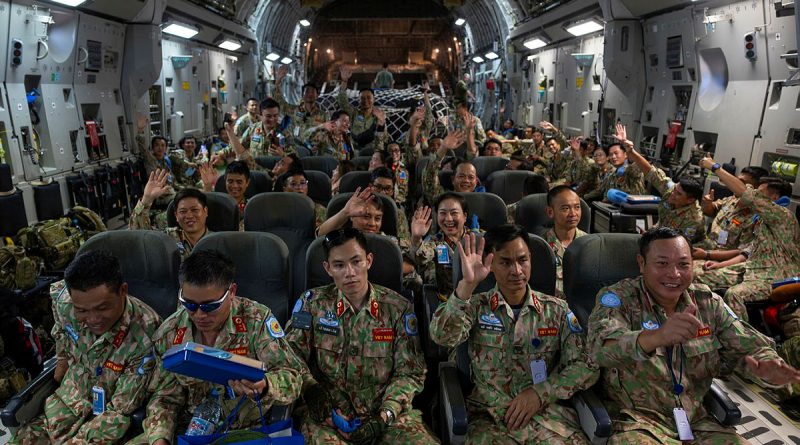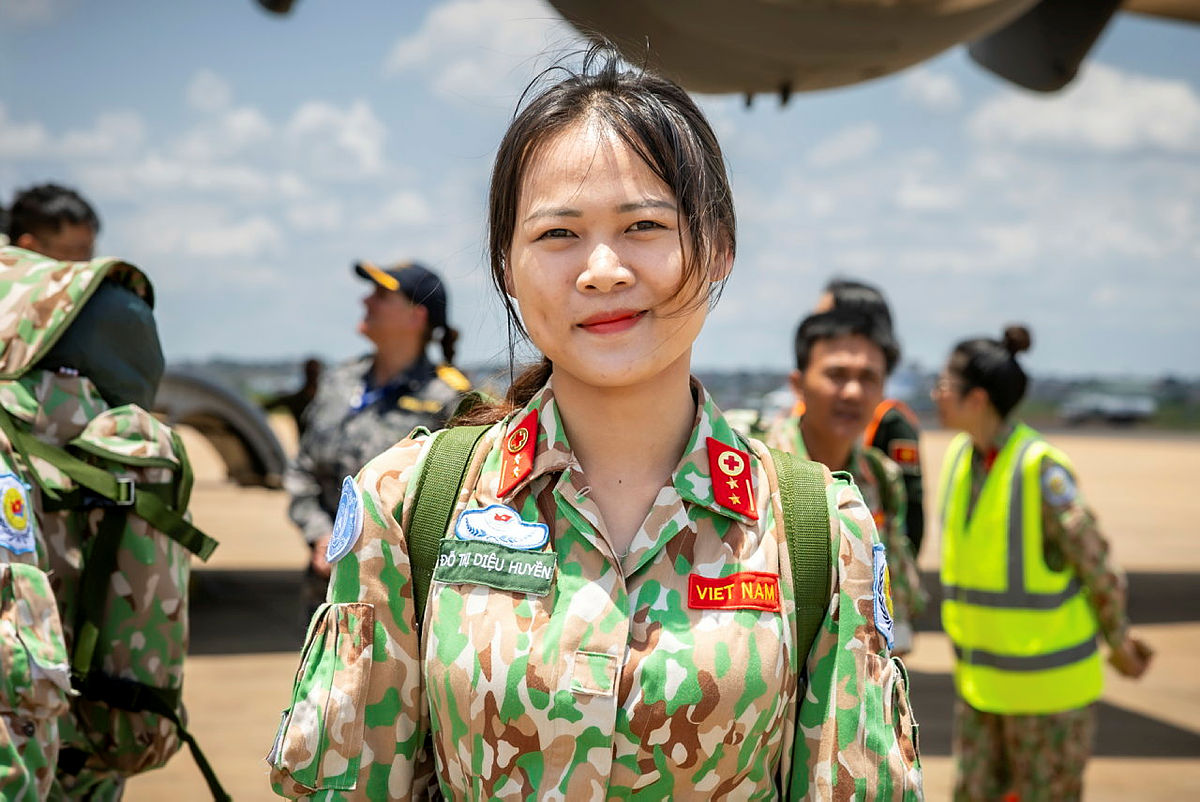Vietnamese medics rotate to South Sudan thanks to RAAF
Share the post "Vietnamese medics rotate to South Sudan thanks to RAAF"

Lieutenant Do Thi Dieu Huyen wanted to show the world a heroic face.
CAPTION: People’s Army of Vietnam UN peacekeepers prepare to take off from Juba International Airport, South Sudan, after boarding a RAAF 36 Squadron C-17A Globemaster during a strategic airlift. Story and photos by Corporal Jacob Joseph.
Lieutenant Phan Nhat Minh Tan looked back on the lives he saved.
One medical officer was about to start her journey. The other was starting his journey home.
Six years after they first sent United Nations (UN) peacekeepers to South Sudan to run a level-two field hospital, hundreds of People’s Army of Vietnam medical personnel, like Lieutenants Huyen and Tan, have travelled to and from South Sudan on Royal Australian Air Force C-17As.
Their level-two field hospital provides intensive care to peacekeepers and refugees in the northern city of Bentiu.
Their latest rotation, which departed Hanoi in late September, was the sixth deployment and the sixth time the Royal Australian Air Force has provided strategic airlift.
CAPTION: People’s Army of Vietnam UN peacekeepers board a RAAF 36 Squadron C-17A Globemaster before departing Juba International Airport, South Sudan, during a strategic airlift.
The UN Mission in South Sudan (UNMISS) was established to protect civilians, monitor human rights and create stable conditions for elections after a devastating civil war.
Defence supports the mission with boots on the ground under Operation Aslan as well as providing strategic capabilities so partner nations can continue peacekeeping efforts.
When Australia supported Fiji to deploy its UN observer force and Bushmasters to the Golan Heights in 2017, the Vietnamese requested similar support for their peacekeeping mission the following year.
The strategic airlift is a source of pride between Australia and Vietnam, according to Australian Embassy Defence Attaché Group Captain Mick Jansen.
Vietnam’s Vice President, along with the Australian ambassador, farewelled the 63 peacekeepers, who wore light-blue berets and marched behind a painting of Ho Chi Minh – a deployment tradition – before boarding the Australian aircraft.
Group Captain Jansen said Defence’s support was in line with the two countries’ developing relationship, after a strategic peacekeeping partnership memorandum of understanding with Vietnam was signed last year.
“Initially we were providing enhanced support to the development of Vietnamese peacekeepers, but through capacity-building activities we now work alongside Vietnamese experts as partners,” Group Captain Jansen said.
In the months leading up to the peacekeepers’ deployment, Defence and embassy personnel provided English lessons, aeromedical-evacuation training and load preparation for the airlift.
“This is where close cooperation between our two nations hits its stride and makes the airlift itself go so smoothly,” Group Captain Jansen said.
“Vietnam has always been grateful for the airlift support – their peacekeepers’ work is a source of national pride.”
For those aboard the C-17A, it was also a source of personal pride.
Lieutenant Huyen was one of the 63 peacekeepers deploying to South Sudan.
CAPTION: People’s Army of Vietnam United Nations peacekeeper Lieutenant Do Thi Dieu Huyen after disembarking a Royal Australian Air Force No. 36 Squadron C-17 Globemaster at Juba International Airport, South Sudan.
She said the blue beret represented her country’s contribution to the international community.
“Vietnamese people love peace,” Lieutenant Huyen said.
“This is a golden chance to give a better life to those in South Sudan.”
The Republic of South Sudan became the world’s newest country in 2011 after the government signed a peace agreement to end a 20-year war with the north in 2005.
The UN Security Council established UNMISS in 2011.
More than 19,000 civilian, police and military personnel in South Sudan are working to enforce the UN mandate from 73 countries, including 14 ADF personnel.
UNMISS is the second largest UN mission behind the UN mission in the Central African Republic.
Lieutenant Tan and 54 other peacekeepers boarded the Australian C-17A in Juba for the return journey to Vietnam.
He was struck by the South Sudanese living conditions when he arrived more than a year ago.
“People have very little. Seeing patients with severe conditions due to a lack of facilities was difficult,” Lieutenant Tan said.
“We saw hundreds, thousands of patients, primarily due to infectious diseases and trauma.
“Conditions are often unhygienic, leading to issues like malaria and infections.”
As UN Military Police ferried the Vietnamese UN personnel between the aircraft and terminal at Juba International Airport, loadmasters from 23 Squadron worked with South Sudanese officials to offload almost 30 tonnes of medical supplies and medicine, enough to sustain the hospital for the next year.
The Australian loadmasters helping to unload the tonnes of cargo from the C-17A, may not have seen the effects of their efforts, but to the Vietnamese who boarded their plane to go home, memories of their contribution are sure to last a lifetime.
“We’ve faced ups and downs, but teamwork allowed us to provide the best treatment possible,” Lieutenant Tan said.
“We saved lives.”
CAPTION: UN Peacekeeper officer Lieutenant Phan Nhat Minh Tan, of the People’s Army of Vietnam, aboard a RAAF 36 Squadron C-17A Globemaster after departing from Juba International Airport, South Sudan.
.
.

.
.
Share the post "Vietnamese medics rotate to South Sudan thanks to RAAF"








